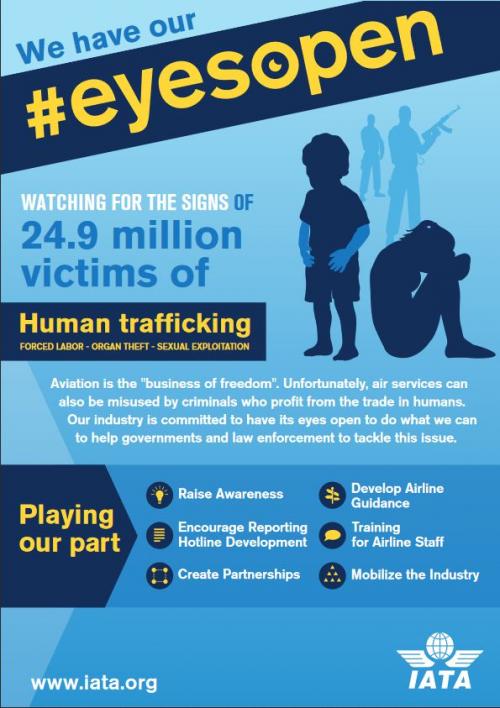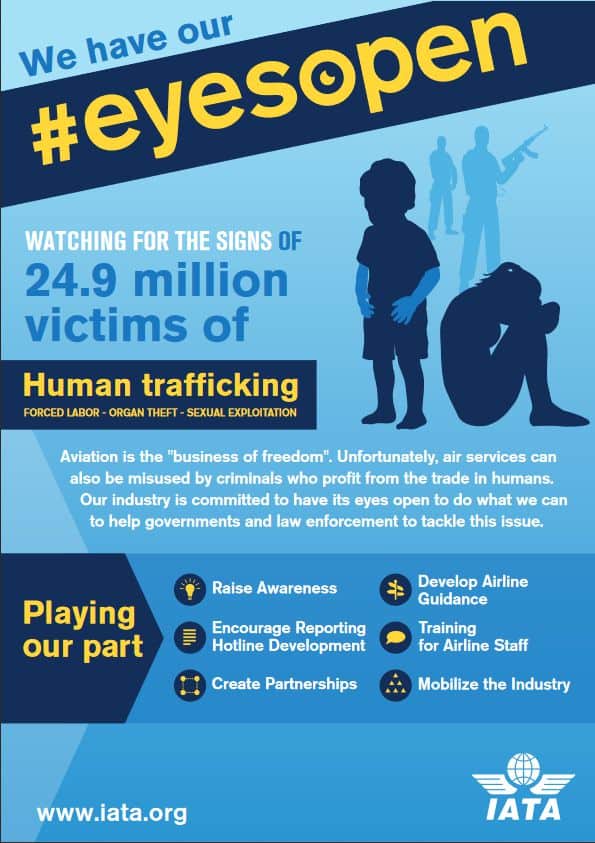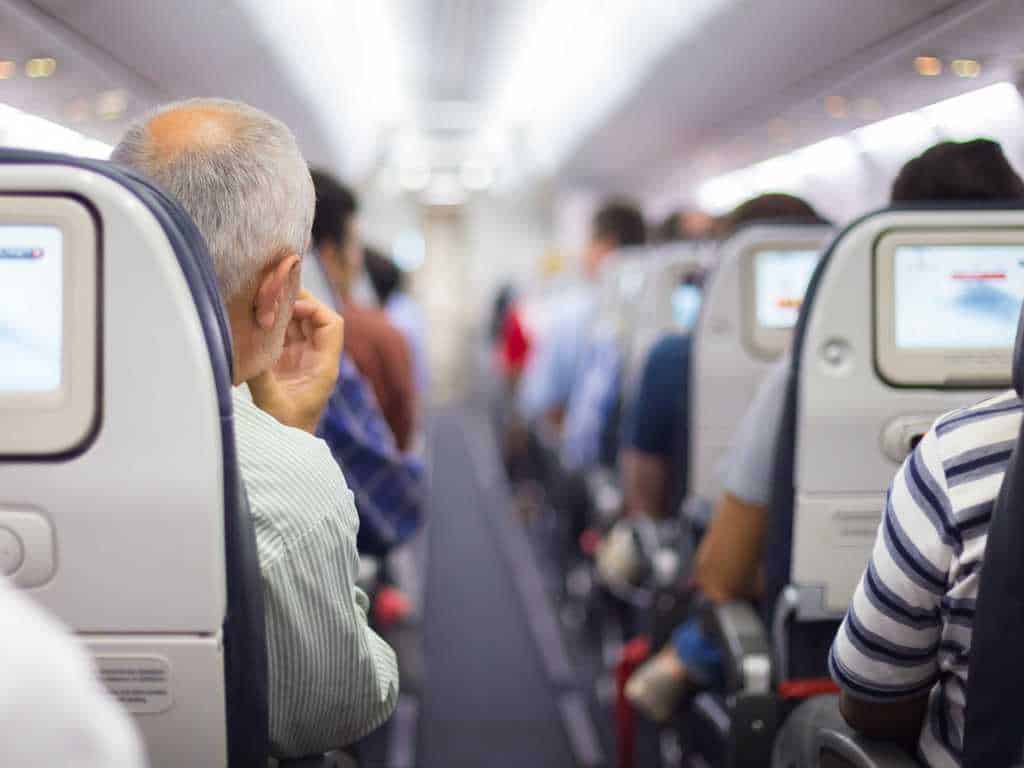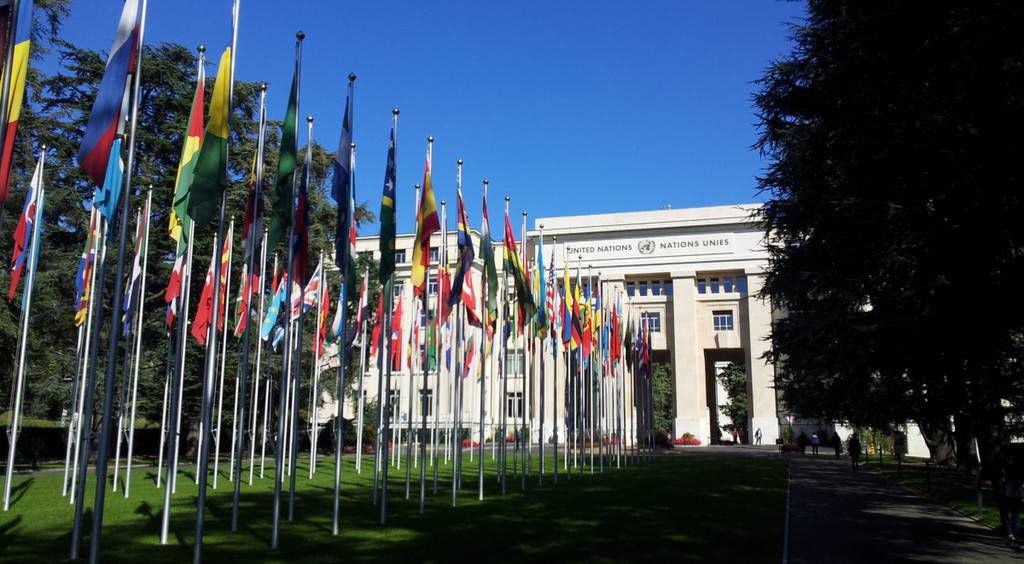
https://www.unitingaviation.com/strategic-objective/security-facilitatio...
Human trafficking – also referred to as trafficking in persons – is a global criminal enterprise second only to the trafficking of drugs and tantamount to modern-day slavery. Victims and perpetrators can sometimes make use of commercial passenger flights, and ICAO has made it a priority to collaborate with the Office of the United Nations High Commissioner for Human Rights (OHCHR) to combat this widespread issue. Together these two agencies have now developed comprehensive guidelines to help airlines train cabin crew to recognize and help combat the trafficking in persons – one flight at the time.
Trafficking in persons is a form of slavery. It involves the trading of human beings for the purposes of exploitation. This exploitation can take different forms: prostitution, forced and bonded labour, forced marriage, organ harvesting.
The International Labour Organization’s (ILO’s) Global Estimates 2017 indicates that some 24.9 million people are currently forced to work under threat or coercion as domestic workers, on construction sites, in clandestine factories, on farms and fishing boats, and in the sex industry. An estimated 15.4 million people are living in forced marriage. This equates to about 5.4 victims of modern slavery for every thousand people in the world.
The financial implications of trafficking in persons are just as staggering, with related activities ranking second only to drug trafficking in terms of profits, measured in billions of dollars.
The first step in combatting this global issue is increasing awareness; the second step is training aviation personnel, including cabin crew members, in recognizing victims and/or perpetrators. Due to the growing numbers of victims being transported by air, cabin crew training is now seen as a key component of the global responses being coordinated by UN agencies such as ICAO, the OHCHR, and the Office on Drugs and Crime (UNODC).

Why is ICAO Involved in the Issue?
As a specialized agency of the United Nations, ICAO recognizes its potential to initiate global action. ICAO actively contributes to the achievement of the UN SDGs adopted under the 2030 Agenda for Sustainable Development, which includes a focus on fighting and combatting trafficking in persons. The Organization worked in collaboration with the OHCHR to develop new guidance material which can serve as a steppingstone for cabin crew training at individual airlines.
The joint ICAO-OHCHR Guidelines for Training Cabin Crew on Identifying and Responding to Trafficking in Persons (Circular 352) are the result of this collaboration. Circular 352 provides States and operators with the framework and topics that should be included in the training package; the material focuses on the identification and response to trafficking in persons and is aimed particularly at the role of cabin crew members.
What Can States Do to Help?
States’ civil aviation authorities should require that operators develop policies, procedures, training and guidance for their employees — specifically to raise awareness on trafficking in persons and appropriate responses to such events.
Youla Haddadin, Advisor on Trafficking in Persons, OHCHR, was an active member of the team of experts that developed the new guidelines. She noted that “this joint circular comes as a good example of cooperation between United Nations entities that are targeting a new constituency and that can play an important role in combatting trafficking in persons.”
If a State has other agencies that mandate or provide training on the identification and response to trafficking in persons, the Civil Aviation Authority (CAA) should leverage partnerships and collaborations that support, update and renew their current initiatives. “We highly recommend that Civil Aviation Authorities use the content of this circular as the basis for training programmes for cabin crew and other aviation personnel,” remarked Ms. Haddadin.

What Can Operators Do to Help?
The aviation industry is one of the primary modes of transportation utilized by traffickers, making it likely that airline personnel will come face-to-face with victims or perpetrators. ICAO recommends that each air operator develop a set of dedicated policies, procedures and reporting protocols for when such encounters occur. Specialized training should be provided to cabin crew, as they would be a first point of recognition onboard, along with flight crew members (pilots), as they would be the first point of reporting suspected cases of trafficking to law enforcement.
Sky Regional Airlines, which operates as Air Canada Express, was the first airline in Canada to implement a joint flight and cabin crew training programme to identify and respond to suspected cases of trafficking in persons onboard. Ms. Mikaela Dontu, Director of Inflight at Sky Regional, pioneered the training programme. “Cabin crew continue to be our best asset when it comes to ensuring the safety, security and wellbeing of our passengers on board,” she said. “It seems only natural to benefit from their expertise. The training we developed is based on specific guidelines and it gives our crews the knowledge and tools they need to handle suspected cases of human trafficking for a best possible outcome.”
How Should Cabin Crew Members Respond to trafficking in persons?
Cabin crew members are in a unique situation where they can observe passengers over a certain period of time, allowing them to use their observation skills to identify a potential victim of trafficking. Cabin crew training already encompasses reactions expected of crew members in various types of situations, from emergency situations to security threats, and the appropriate responses expected from them. If cabin crew members suspect a case of trafficking in persons onboard, a proper assessment of the situation is necessary before any response can be initiated. Cabin crew members should be on the lookout for certain key indicators that may be present in the cabin environment which can help cabin crew members with that assessment, such as: passengers who avoid eye contact and social interaction, who are not in control of their travel documents, or who are not wearing appropriate clothing for their destination.
The role of cabin crew should be limited to observing the situation, initiating non-threatening conversations with the suspected victims to gather information, and reporting their concerns to the Captain, who will ultimately decide if law enforcement needs to be alerted. Suspected cases of trafficking in persons are dealt with by law enforcement. Therefore, cabin crew members should not confront the suspected traffickers or try to rescue the victims, as this may do more harm. This notion is reflected in the concept of “Do No Harm,” which is meant to ensure that a potential victim is not further jeopardized and to safeguard the crew members and passengers.

Going Beyond the Cabin
Although the content of the guidelines is applicable to cabin crew members, the issue of trafficking and combatting it involves several stakeholders, not just the cabin crew. In addition to flight crew, all personnel at airports should also be trained to recognize trafficking in persons and how to report any suspected case to the appropriate authorities. The content of Circular 352 may be used and adapted to create training packages for different transportation stakeholders (i.e. trains, buses, cruise lines).
Bringing the Stakeholders Together
ICAO and OHCHR will hold a joint Forum to Combat Human Trafficking in Aviation in Geneva, Switzerland on 28 May 2018. The event will bring together representatives from States, human rights organizations, and industry. Kate Gilmore, UN Deputy High Commissioner for Human Rights, and Dr. Fang Liu, Secretary General of ICAO, will open the event, where States and airlines will share their initiatives to combat trafficking in persons and exchange best practices to further advance the issues. “Our goal with this initiative is to ensure that civil aviation’s remarkable ability to connect global citizens and societies is not abused by those with such malicious intent,” said Dr. Lui. “States and Civil Aviation Authorities can contribute to this noble aim by adopting the new guidelines we developed and by disseminating them to the airline operators registered in their national jurisdictions.”
Information on the forum is available here, there is no registration fee to attend the event.
The ICAO Manual on Information and Instructions for Passenger Safety (Doc 10086) is now available to States in English on the ICAO-NET at http://portal.icao.int/. Additional information can be obtained here on the ICAO Cabin Safety Website.
 About the Author
About the Author
Martin Maurino is the Safety, Efficiency and Operations Officer at ICAO who heads the ICAO Cabin Safety Programme. Before joining ICAO, he held safety analysis and safety management roles at Transport Canada and the International Air Transport Association (IATA). Martin began his career in aviation as a cabin crew member at Air Canada.










Add new comment